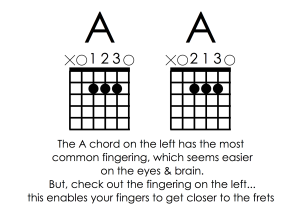It’s a game of millimeters, I tell you.
The slightest adjustments can create optimum results when it comes to chord clarity.
And that is one of our prime directives as guitarists… to have the chords we play ring out cleanly, clearly, and for as long as possible.
(meaning, sustain is good!)
So when you work on your chords and they don’t sound right, what do you adjust?
Do you just wiggle your fingers around until it sounds good?
Just what exactly does one do to change the chord from a bevy of buzzes, thumps & rattles into a miniature symphony of euphonious timbres?
(wow… I said that beautifully)
As with any process, having a clear idea of the goal is crucial.
And here, the goal is to have every note in a chord you are holding ring out clearly & sustain for as long as it can.
Let’s discuss the particulars of what will impede said clearness & sustainness (not a word).
1. Fret/Finger Proximity
You need to know that you are always striving to put your fingertips on the strings as close as possible to the fret you are behind. The further away you are from the fret, the more likely that note will buzz & rattle. This is because the string is vibrating between the saddle (down by your right hand) and the fret. If your are not close to the fret, than the string will actually bounce up & down on the fret and result in that rattling buzzy sound. So the leverage you are applying with your left hand fingertip is imperative.
Notice I said above, “striving to…”. Sometimes, depending on the chord fingering, the fingertips are crammed together and you can only get so close to the fret. In this case, do the best you can to scoot the fingertips right up to the fret as possible. Fortunately, if you are not more than 50% of the way between the two frets, you should be fine. Although every guitar will be different in this regard. It’s depends on how the guitar is set up. (this week’s research assignment: look up “guitar set up”)
And this is where you could consider trying different fingerings to maximize fret/finger proximity…
2. One of the other fingers is touching the string
This is the usually culprit when you hear a thump instead of a ringing guitar string. Here is where it’s really a game of millimeters.
Fortunately, you just have to be barely not-touching the string with another finger for it not to interfere with it’s vibration.
I would go so far as to say that this is the number one challenge for beginning guitar students who are working on their very first chords.
(well, then why didn’t I list it as #1 in this list? hmm)
But guess what? This will always be an issue for the rest of your guitar playing life. Almost any chord you ever deal with will have to have each finger doing it’s job without touching something it’s not suppose to touch. Some chords are trickier than others, of course, but there is always a way to position your fingers to achieve clearance where it needs to be achieved.
One more thing…
An effective approach to getting your finger away from a string is to pick up the offending finger and play more off the back part of the tip, or the front part of the tip, accordingly. This is a good way to gain a millimeter, or two.
And also…
Remember, it doesn’t matter if you touch the string behind another fretting finger. This will not affect that string at all.
Oh, and heads-up…
If a string is ever-so-slightly vibrating against the fleshy part of another finger, it will result in a buzzy sound, not a thump, when you pick it.
This just means you’ve achieved a nanometer distance between your finger & the string.
Well done. Now, stop it.
Okay, that was three more things.
Moving on…
3. Finger Pressure
Most people in the beginning think that this is what will be their greatest challenge in learning guitar technique- holding the string down hard enough. But, as it turns out, it doesn’t really take that much pressure to hold a string down against the fret.
However, If your guitar has really heavy gauge strings & really high action, exertion might be an issue.
But most of the time, you don’t really have to put a death grip on your chords. As a matter of fact, most people often use too much pressure, which can result in fatigue, let alone causing the string to go out of tune.
Try this…
Take your first finger & put it on the 6th string at the 5th fret. Hold it firmly, like you normally would.
Now, very gradually release the pressure until the string starts to buzz, then press back down just enough to get the note to ring clearly.
This will show you exactly how much pressure is necessary. Try this with the other fingers on the other strings at various frets. Make it a ninja-like experience to discover how to play with a light touch. Maximum results with minimal effort!
4. Being right on top of the fret
If your fingertip is directly on top of the fret as you hold the string, the note will sound slightly, or completely muted. See #1 above.
As is frequently the goal on the path of guitar consciousness-raising, you want to point your own awareness towards your own playing & your own sound. Listen carefully to each note in the chord. Play the strings one at a time. If there are any issues, than diagnose the situation & see if any of these things discussed here are what are responsible. Then make adjustments. If you don’t change anything in your approach, than the situation will remain the same.
Which is a basic tenet for all of life, ya know.
More on that later. At this rate, I figure I’ve got 1500 more blogs left in me.
There’s no rush. That’s many milliseconds away.




Leave A Response